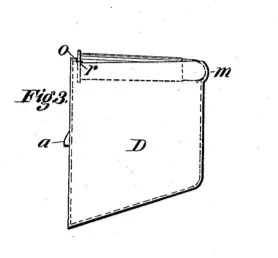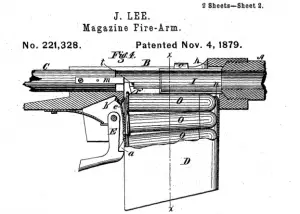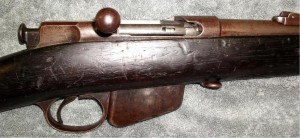 A couple of days ago, we addressed the question: what was the first detachable box magazine?
A couple of days ago, we addressed the question: what was the first detachable box magazine?
Since then, another approach occurred to us, when trying to confirm Borchardt’s primacy. And it led us to something we’d only hinted at before. Looking at the word PATENT engraved on the side of a Borchardt magazine, what about Borchardt’s patents? All US patents are trivially searchable at Google’s patent server (hugely superior to the USPTO’s own search, or the IBM patent server we used to use).
The Google server has its limitations, mostly due to the limits of the Optical Character Recognition software used to turn images into searchable text.. .Borchardt comes out as JUKCHARDT in one of his patents. But beginning with patent numbers off one of his later pistols, and a list of patent numbers on his Wikipedia entry, we examined all his claims.
And, while he claimed putting the magazine in the grip for a compact pistol, he didn’t claim the detachable magazine, period. Now, was that because he thought it was obvious, and therefore not patentable; or because there was prior art? 19th-Century patents were generally less informative about prior art than current ones, but we were able to work back through the inventions of Arthur F. Bellinger, probably employed by E. Remington and Sons in upstate New York, to the patents of James Paris Lee, definitely associated with Remington — one of the eponymous sons witnessed some of Lee’s patent applications.
And that led us to paydirt: Lee’s patent of November 4, 1879, Number 221,328. As Lee wrote in his patent claim:
The detachable magazine D, provided with the cavity m, and the inwardly projecting shoulders o and r, or their equivalents…
A detachable magazine or cartridge-holder D, having its front and rear ends of different lengths, with one of its sides or edges open for the insertion and removal of the cartridges, and provided with a spring-follower and cartridge retaining devices.
The same patent also shows a magazine bearing a slight similarity to the rotary magazine used on Krag and later Johnson rifles, but the simpler magazine is the one that went into production.
For the Lee box magazine wasn’t just a patent. It was produced, albeit in small numbers, in 1879, 1882, and 1889 versions, both as military and sporting rifles. (The Navy bought a few of the military rifles). Many of them have survived and they regularly show up on Gun Broker, generally in .45-70 and .30-40 calibers. Lee had many other inventions — one of his bolt actions used a straight-pull mechanism.
 The Lee rifles also contained a feature that’s a very quaint anachronism today, when even our sniper rifles tend to be semiautomatic and an infantry squad has more mad-minute firepower than a battalion of the Indian Wars era. You see, repeating rifle technology was at once wanted and feared by Army leaders of the era. They were concerned that the troops would blaze away and waste ammunition, running out, or at least, overtaxing supply trains. So the Lee could be used as a repeater with the magazine in, or, if the magazine was removed, a small steel piece blanked the opening so that .45-70 rounds could be single-loaded. It does seem strange to us now, with even our pistols holding 15 rounds, but many patents of the period provided some method for the rifle to convert between economical single-shot use to magazine-fed rapid fire. Remington’s Bellinger got a patent for adding a second notch to the Lee magazine, letting it stay in the magwell but drop down out of engagement with the bolt, allowing single loading.
The Lee rifles also contained a feature that’s a very quaint anachronism today, when even our sniper rifles tend to be semiautomatic and an infantry squad has more mad-minute firepower than a battalion of the Indian Wars era. You see, repeating rifle technology was at once wanted and feared by Army leaders of the era. They were concerned that the troops would blaze away and waste ammunition, running out, or at least, overtaxing supply trains. So the Lee could be used as a repeater with the magazine in, or, if the magazine was removed, a small steel piece blanked the opening so that .45-70 rounds could be single-loaded. It does seem strange to us now, with even our pistols holding 15 rounds, but many patents of the period provided some method for the rifle to convert between economical single-shot use to magazine-fed rapid fire. Remington’s Bellinger got a patent for adding a second notch to the Lee magazine, letting it stay in the magwell but drop down out of engagement with the bolt, allowing single loading.
So far we have not found a rival to Mr Lee for primacy of design, so the present state of our knowledge is this: James P. Lee appears to be the original inventor of the detachable box magazine. Hugo Borchardt, conversely, appears to be the first designer whose weapon shipped with spare magazines (the Lee mags were generally furnished one-per-rifle).
Of course, this is research, so it’s all liable to be overturned by tomorrow’s finding. What fun!
(Images: Apart from the patent drawings, from this thread at milsurps.com. Many more images of an original 1879 Remington-Lee there, and much further information including tech on the magazine).

Kevin was a former Special Forces weapons man (MOS 18B, before the 18 series, 11B with Skill Qualification Indicator of S). His focus was on weapons: their history, effects and employment. He started WeaponsMan.com in 2011 and operated it until he passed away in 2017. His work is being preserved here at the request of his family.
